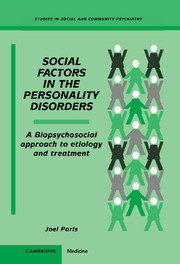Book contents
- Frontmatter
- Contents
- Foreword
- Introduction
- Acknowledgments
- 1 Overview
- 2 Personality Traits and Personality Disorders
- 3 Biological Factors
- 4 Psychological Factors
- 5 Social Factors – Methods
- 6 Social Factors – Mechanisms
- 7 A Biopsychosocial Model of the Personality Disorders
- 8 The Odd Cluster
- 9 The Impulsive Cluster
- 10 The Anxious Cluster
- 11 Treatment
- 12 Clinical Practice
- Epilogue: Summary and Research Implications
- References
- Index
7 - A Biopsychosocial Model of the Personality Disorders
Published online by Cambridge University Press: 05 May 2010
- Frontmatter
- Contents
- Foreword
- Introduction
- Acknowledgments
- 1 Overview
- 2 Personality Traits and Personality Disorders
- 3 Biological Factors
- 4 Psychological Factors
- 5 Social Factors – Methods
- 6 Social Factors – Mechanisms
- 7 A Biopsychosocial Model of the Personality Disorders
- 8 The Odd Cluster
- 9 The Impulsive Cluster
- 10 The Anxious Cluster
- 11 Treatment
- 12 Clinical Practice
- Epilogue: Summary and Research Implications
- References
- Index
Summary
In the previous four chapters, we have separately considered the roles of biological, psychological, and social risk factors in the personality disorders. None of these factors are sufficient, by themselves, to explain why traits become amplified to disorders. The present chapter will therefore propose an integrated biopsychosocial theory of the etiology of personality disorders.
The proposed model will hypothesize that only the cumulative and interactive effects of many risk factors can explain how personality disorders develop. It will also consider the influence of protective factors, those biological, psychological, or social influences that make the development of disorders less likely.
Again, we must acknowledge that our data base concerning the etiology of personality disorders is preliminary. Therefore, the discussion here will necessarily be somewhat speculative. The proposed model should be considered primarily as a stimulus for further research.
Biological factors: the role of personality traits
Personality disorders are amplifications of personality traits. The relationship between traits and disorders is continuous. Trait profiles constitute the diatheses for personality disorders, and determine which specific types of disorder can develop in any individual.
Personality can be characterized by a large number of traits, some of which will be more adaptive, others less adaptive (Kagan, 1994). The biological risk factors for personality disorders would consist of an unusual intensity of less adaptive traits, unbuffered by the more adaptive traits. For example, emotional instability and impulsivity could, particularly in combination, be a risk factor for impulsive personality disorders; on the other hand, coexisting adaptive traits, such as persistence (Cloninger et al., 1993), might be protective against these disorders.
- Type
- Chapter
- Information
- Social Factors in the Personality DisordersA Biopsychosocial Approach to Etiology and Treatment, pp. 95 - 101Publisher: Cambridge University PressPrint publication year: 1996



